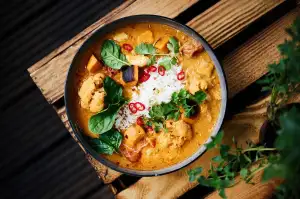Exploring the Irresistible Fusion: Unveiling the Magic of British Chinese Food

British Chinese food is a delightful culinary fusion that combines the best of both worlds. It is a unique blend of traditional Chinese flavors and cooking techniques with British ingredients and influences. This delectable cuisine has gained immense popularity in the United Kingdom, offering a tantalizing array of dishes that cater to diverse palates. From mouthwatering stir-fries to comforting noodle dishes, British Chinese food promises an unforgettable dining experience filled with bold flavors and exciting textures. Join us on a journey as we unravel the magic of this irresistible fusion cuisine.
History and Cultural Influences
British Chinese food has a rich history that dates back to the early 19th century. It was during this time that Chinese immigrants began to settle in Britain, bringing with them their culinary traditions and flavors. These early settlers were primarily from the southern regions of China, such as Guangdong and Fujian provinces.
The cultural influences on British Chinese food are vast and diverse. The Cantonese style of cooking, with its emphasis on fresh ingredients and delicate flavors, became the foundation for many popular dishes. Other regional styles, such as Sichuan and Hunan, also made their mark on British Chinese cuisine, adding a spicy and bold dimension to the flavors.
Over the years, British Chinese food has evolved and adapted to suit local tastes. Traditional Chinese ingredients were often substituted with locally available ones, resulting in unique flavor combinations. For example, soy sauce was replaced with Worcestershire sauce in some dishes, giving them a distinct British twist.
The fusion of Chinese and British culinary traditions is evident in popular dishes like sweet and sour chicken, crispy duck pancakes, and chow mein. These dishes combine the techniques and flavors of both cuisines to create something truly delicious.
Cultural assimilation has also played a role in shaping British Chinese food. Many second-generation Chinese immigrants have embraced their dual heritage by creating dishes that blend traditional Chinese flavors with modern British ingredients. This fusion of cultures has given rise to innovative creations like salted egg yolk prawns and black bean beef burgers.
Overall, the history and cultural influences behind British Chinese food have resulted in a unique culinary experience that is loved by people all over Britain. The combination of traditional techniques, local ingredients, and fusion adaptations make it an irresistible cuisine that continues to evolve with time.
Popular British Chinese Dishes
British Chinese cuisine offers a wide range of delectable dishes that have become beloved favorites among locals. One of the most popular dishes is Sweet and Sour Chicken, featuring tender pieces of chicken in a tangy sauce with peppers and pineapple. Another crowd-pleaser is Crispy Duck, where succulent duck meat is roasted until crispy and served with pancakes, cucumber, and hoisin sauce.
Other must-try dishes include Beef Chow Mein, a stir-fried noodle dish with tender beef and crunchy vegetables, and Prawn Toast, which consists of minced prawns spread on bread slices and deep-fried to perfection. The ever-popular Lemon Chicken showcases crispy chicken coated in a zesty lemon sauce.
For those seeking a spicy kick, Kung Pao Chicken is a fiery delight with diced chicken, peanuts, and dried chili peppers. And let's not forget the classic Egg Fried Rice – fluffy rice stir-fried with eggs and various vegetables or meats.
These dishes represent just a fraction of the tantalizing options available in British Chinese cuisine. Each dish combines traditional Chinese flavors with British culinary influences to create unique and mouthwatering creations that keep diners coming back for more.
Ingredients and Flavors
British Chinese food is a delightful fusion of traditional Chinese ingredients with British cooking techniques and flavors. The use of fresh vegetables, meats, seafood, and aromatic spices is at the heart of this cuisine. Some commonly used ingredients include soy sauce, ginger, garlic, oyster sauce, sesame oil, and five-spice powder.
The flavors in British Chinese food are bold and vibrant. Sweet and sour dishes are a popular choice, combining tangy vinegar with a hint of sweetness from sugar or pineapple. Other flavor profiles include spicy dishes infused with chili peppers or Szechuan peppercorns for a fiery kick. Umami-rich sauces like black bean or hoisin add depth to stir-fries and noodles.
The combination of these ingredients and flavors creates a unique taste that is distinctly British Chinese. It's a harmonious blend of savory, sweet, sour, and spicy notes that tantalize the taste buds and leave you craving for more. Whether it's the crispy texture of deep-fried dishes or the comforting warmth of a steaming bowl of noodle soup, British Chinese food offers an array of flavors to satisfy every palate.
Fusion and Adaptations
One of the most fascinating aspects of British Chinese food is its fusion of flavors and adaptations. Over the years, Chinese cuisine in Britain has evolved to incorporate local ingredients and cater to British tastes. This blending of culinary traditions has resulted in a unique and delicious fusion.
Traditional Chinese dishes have been adapted to suit British palates by reducing the spiciness and adding more sweetness. For example, the popular dish Sweet and Sour Chicken originated from the Cantonese region but has been modified with a tangy sauce made from vinegar, sugar, and ketchup.
Another adaptation is seen in the use of ingredients like chips (French fries) in dishes such as Sweet and Sour Pork with Chips or Chicken Chow Mein with Chips. This combination reflects the British love for chips and adds a delightful crunch to these dishes.
Furthermore, British Chinese cuisine has also incorporated influences from other Asian cuisines, such as Thai or Indian flavors. Dishes like Singapore Noodles or Thai Green Curry have become staples on many Chinese takeaway menus, showcasing the diverse range of flavors available.
The fusion doesn't stop at just flavors; presentation plays an important role too. In traditional Chinese cuisine, dishes are often served family-style with multiple dishes shared among diners. However, in British Chinese restaurants, individual portions are more common to cater to Western dining habits.
This fusion and adaptation of flavors and presentation make British Chinese food truly unique. It combines the best of both worlds – traditional Chinese cooking techniques with local ingredients and tastes – resulting in a culinary experience that is both familiar and exciting for diners.
Next up: Regional Variations
Regional Variations
Just like any other cuisine, British Chinese food has its own regional variations that add to its diverse and unique flavors. While the overall concept of British Chinese food remains consistent across the country, each region has its own twist on traditional dishes.
In London, for example, you'll find a strong influence from Cantonese cuisine. This is due to the large number of Cantonese immigrants who settled in the city in the 20th century. The dishes here tend to be lighter and more delicate, with an emphasis on fresh ingredients and subtle flavors.
In Birmingham, on the other hand, you'll find a fusion of Cantonese and Szechuan influences. The dishes here are known for their bold and spicy flavors, thanks to the use of Szechuan peppercorns and chili peppers.
In Manchester, there is a strong influence from Hong Kong-style cuisine. The dishes here are often characterized by their rich sauces and hearty portions.
Other regions also have their own unique take on British Chinese food. In Glasgow, for example, you'll find a blend of Cantonese and Scottish influences, resulting in dishes like haggis fried rice or deep-fried Mars bars with sweet and sour sauce.
These regional variations highlight the adaptability of British Chinese food and how it has evolved to suit local tastes. Whether you're in London or Manchester or anywhere else in Britain, you can be sure to find a delicious fusion of Chinese flavors with a British twist.
Eating Chinese Food in Britain
Eating Chinese food in Britain is an experience that is both familiar and unique. With a long history of Chinese immigration, British cities have become home to a wide range of authentic Chinese restaurants. From bustling Chinatowns to hidden gems tucked away in residential areas, there are countless options for those craving a taste of the Orient.
One of the most exciting aspects of dining at a Chinese restaurant in Britain is the diversity of regional cuisines on offer. Whether you prefer the fiery flavors of Sichuan cuisine or the delicate dim sum from Cantonese kitchens, you can find it all here. Many restaurants also offer a fusion of different regional dishes, allowing diners to explore new and exciting flavor combinations.
In addition to traditional sit-down restaurants, Chinese takeaways have become an integral part of British culinary culture. These establishments offer quick and convenient meals that can be enjoyed at home or on the go. From classics like sweet and sour chicken to more adventurous dishes like crispy duck pancakes, takeaways provide a taste of China that can be enjoyed by everyone.
When dining at a Chinese restaurant or ordering from a takeaway, it's important to remember that British Chinese food has adapted to suit local tastes over time. While some dishes may be similar to their counterparts in China, others have been modified with ingredients and flavors that appeal to British palates. This fusion creates a unique culinary experience that combines the best of both worlds.
Whether you're enjoying a leisurely meal at a restaurant or grabbing a quick bite from a takeaway, eating Chinese food in Britain offers a glimpse into the rich cultural heritage and diverse flavors that make up this beloved cuisine. So next time you're craving some mouthwatering noodles or fragrant stir-fried vegetables, don't hesitate to indulge in the magic of British Chinese food.
The Rise of Chinese Takeaways
One of the most significant developments in the British Chinese food scene has been the rise of Chinese takeaways. These establishments have become a staple in many towns and cities across Britain, offering a convenient and affordable way to enjoy Chinese cuisine.
Chinese takeaways first gained popularity in the 1950s when Chinese immigrants started opening small restaurants and takeaway shops. These establishments quickly became popular among locals who were drawn to the exotic flavors and affordable prices.
Over time, Chinese takeaways evolved to cater to the British palate, adapting traditional dishes to suit local tastes. Sweet and sour chicken, crispy duck pancakes, and chow mein are just a few examples of dishes that have become synonymous with British Chinese takeaways.
Today, Chinese takeaways are an integral part of British food culture. They offer a wide range of dishes, from classic favorites to innovative fusion creations. The convenience of ordering online or over the phone has made them even more accessible, ensuring that people can enjoy their favorite Chinese dishes from the comfort of their own homes.
Chinese takeaways have also played a role in introducing new ingredients and flavors to British cuisine. Ingredients like soy sauce, ginger, and spring onions have become pantry staples for many households across Britain.
Despite their popularity, Chinese takeaways have faced some criticism for their high levels of salt, sugar, and unhealthy cooking methods. However, many establishments are now making efforts to offer healthier options by reducing salt content and using fresher ingredients.
Overall, the rise of Chinese takeaways has brought the flavors of China into the homes and hearts of millions in Britain. They continue to be a beloved part of British food culture, providing a taste of China's rich culinary heritage with each delicious bite.
British Chinese Food in the Modern Culinary Scene
British Chinese food has come a long way since its humble beginnings. Today, it has firmly established itself in the modern culinary scene, captivating taste buds and gaining popularity among food enthusiasts. The fusion of British and Chinese flavors has created a unique and exciting dining experience that continues to evolve.
In recent years, there has been a surge in innovative British Chinese restaurants that are redefining traditional dishes with a contemporary twist. Chefs are experimenting with new ingredients, techniques, and presentation styles to create exciting and visually stunning dishes. This modern approach to British Chinese cuisine is attracting a younger generation of diners who crave bold flavors and creative culinary experiences.
Furthermore, the rise of social media platforms has played a significant role in promoting British Chinese food. Food bloggers and influencers share their dining experiences at these modern establishments, showcasing the vibrant colors, intricate plating, and mouthwatering flavors that make British Chinese cuisine so enticing.
Additionally, the demand for vegetarian and vegan options has influenced the evolution of British Chinese food. Restaurants are now offering plant-based versions of popular dishes like sweet and sour tofu or vegetable chow mein. This adaptation not only caters to dietary preferences but also highlights the versatility and adaptability of British Chinese cuisine.
Overall, British Chinese food continues to thrive in the modern culinary scene by embracing innovation while staying true to its roots. It offers a delightful blend of flavors, textures, and aromas that appeal to both locals and visitors alike. Whether you're indulging in classic favorites or exploring contemporary creations, British Chinese cuisine promises an unforgettable gastronomic adventure.
In conclusion, British Chinese cuisine offers a unique and delightful fusion of flavors that has captivated the taste buds of millions. With its rich history and cultural influences, this culinary tradition has evolved into a beloved part of British food culture.
From classic dishes like sweet and sour chicken to innovative adaptations such as crispy duck pancakes, British Chinese food showcases a harmonious blend of ingredients and flavors. The use of fresh vegetables, aromatic spices, and succulent meats creates a symphony of tastes that is both comforting and exciting.
What sets British Chinese cuisine apart is its ability to adapt and fuse with local ingredients and cooking techniques. This flexibility has resulted in regional variations that reflect the diverse culinary landscape of Britain. Whether you're in London or Manchester, you can find unique twists on traditional Chinese dishes that cater to local preferences.
Eating Chinese food in Britain has become a cherished experience for many. From bustling Chinatowns to neighborhood takeaways, there are endless options to satisfy your cravings for delicious noodles, dumplings, and stir-fried delights. The rise of Chinese takeaways has made it even more convenient for people to enjoy these mouthwatering dishes from the comfort of their homes.
In the modern culinary scene, British Chinese food continues to thrive and evolve. Chefs are experimenting with new ingredients and techniques to create innovative dishes that push the boundaries of traditional flavors. This fusion of cultures not only celebrates diversity but also introduces exciting new tastes to the dining table.
So next time you're looking for an unforgettable gastronomic adventure, don't miss out on exploring the magic of British Chinese cuisine. Indulge in its unique flavors, savor its rich history, and let your taste buds be transported on a journey that combines the best of both worlds - Britain and China.
Published: 30. 11. 2023
Category: Food



